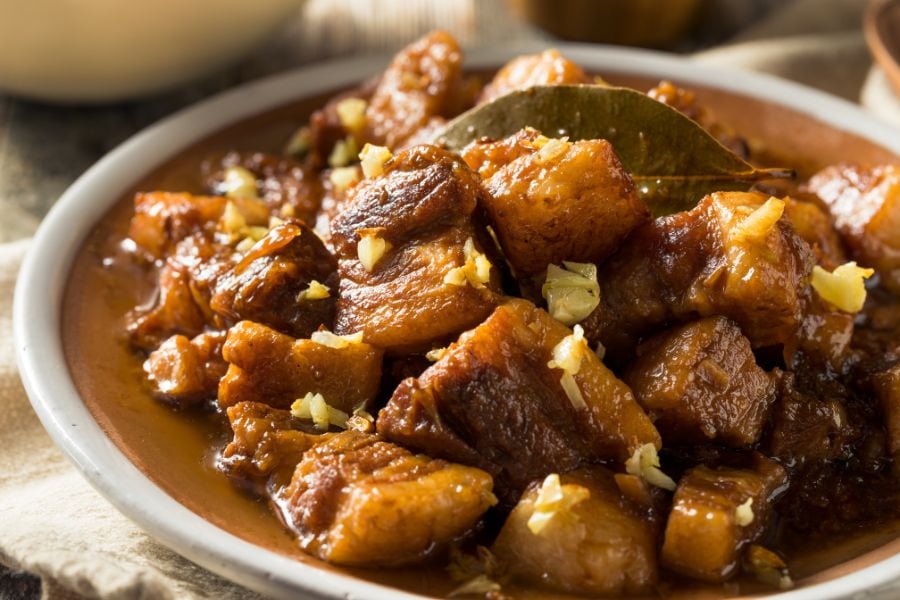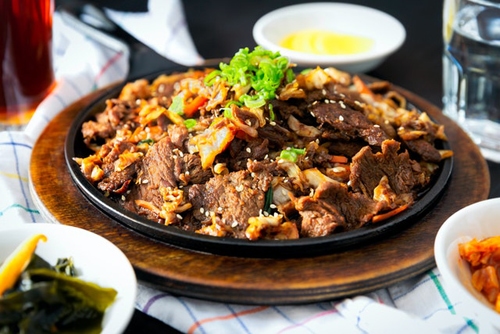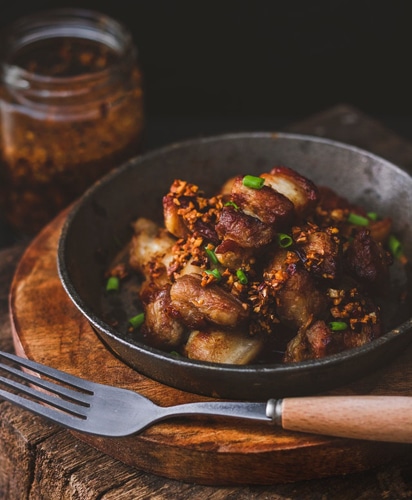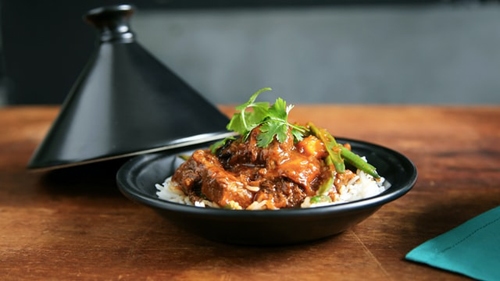I was only introduced to pork adobo in culinary school but fell in love with it immediately. Ever since then, I have been researching the various variations and trying to figure out which one works the best for me.
In this post, I will introduce you to the recipe and show you all the tips you need to know to get this dish right. Let’s get started!

While this post is largely about the recipe for pork adobo, I feel like a little bit of a cultural lesson is in order to do this dish justice.
The first thing that I want to clear up is what adobo actually is. Now, you are most likely to be aware of Filipino adobo, the truth is that a version of this dish is also prepared in Spain, the Caribbean, and even Mexico!
Although this term can be used to describe sauce and seasoning, it is more accurate to describe it as a cooking technique.
It is where the meat is marinated in a sauce, browned, and then cooked in the marinade.
Historians believe that adobo originated due to a need to keep meat safe before refrigerators were invented. Cooking the meat in salt and vinegar took care of this.
While you may be more familiar with chicken adobo, pork adobo is just as popular.
The other thing that I want to share with you is that there is more than one version of Filipino pork adobo. There are 7,640 islands in the Philippines and you are likely to find a version for every one of them.
Some contain coconut milk while others skip out on the soy sauce. There are versions that contain turmeric while some other regions may prefer annatto.

The traditional Filipino pork adobo uses pork belly. However, you will find just as many recipes that use pork belly.
Why is this and which one should you use?
Well, pork belly is commonly used in Asian recipes but has only recently become popular in the States. Due to this, it isn’t always easy to find pork belly.
Pork shoulder, on the other hand, is far easier to find. Therefore, it makes sense as a substitute for pork belly.
The only tip that I want to give you is that the shoulder is a tougher cut of meat while the pork belly contains more fat. As a result, you often have to cook the shoulder for longer.
Place the pork belly in a glass container. Add the ingredients of the marinade and mix well.
Cover the bowl with plastic wrap and place it in the refrigerator. Let the pork marinate for at least 30 minutes.
Heat oil in a pan.
Add the pork and the other ingredients of the marinade. Cook the pork, turning it every so often until all the sides are browned.
Combine the ingredients of the sauce in a bowl. Stir until the sugar is dissolved.
Add soy sauce vinegar mixture to the pot.
Let the ingredients boil for 5 minutes.
Then, lower the heat and cover, simmering. Cook pork adobo for up to 50 minutes or until the pork is tender when poked with a fork.
If the sauce hasn’t reduced, uncover the pork adobo and cook until it gets thicker.
Take off heat and serve while it is hot over steamed rice.

I do suggest using pork belly to make Filipino pork adobo – it is far more authentic. This is a fatty cut and results in a nice and juicy pork dish.
If you can’t find pork belly or are worried about the saturated fat, then the shoulder cut will do.
The thing is that the shoulder cut is tougher. Due to this, I would suggest cooking adobo made from the shoulder in a Dutch oven.
You may also want to use about another tablespoon of oil in the recipe. As mentioned, pork belly is fattier and a little bit of extra oil will add flavor.
Technically, no you don’t need to marinate the meat before cooking it. Still, if you want to make traditional Filipino pork adobo, I suggest that you do it.
Also, the meat doesn’t have to be marinated for too long – 30 minutes will do.
The sauce that I have provided for this pork adobo recipe is a more traditional take on the adobo recipes. This may not be suitable for some palates – you find that there is too much soy sauce or vinegar.
If you are sensitive to salt, then I would suggest using low sodium soy sauce. Only use the light sauce as dark soy sauce doesn’t do much beyond adding color.
Add 1/3 cup of soy sauce combined with 1/4 cup of vinegar. Add in the sugar and water. Taste and see if this is just right or if it could use more of a kick.
If you want more flavor, then add in the rest of the soy sauce and vinegar as stated in the recipe.
You can skip the brown sugar if you don’t want any sweetness.
As you are aware, you can’t actually eat bay leaves which is why most people remove it from the pot once the dish has finished cooking.
Others may not appreciate whole peppercorns in their food either.
To cut down on the hassle of removing these elements, tie them up in a cheesecloth or a seasoning ball. Add this into the sauce.
This way, the flavors of the seasoning are imparted but there is no messy removal afterwards.
There is another way to cook this adobo recipe. In this other version, you first add the vinegar alone once the pork has been browned. Then, cook for about 5 minutes.
Then, you add the rest of the sauce ingredients.
Now, you should be warned that this does allow for a stronger vinegar flavor. If this isn’t something that you will appreciate, follow the method mentioned in the initial recipe.

Ended up with leftovers? Not a problem!
First, let the adobo cool completely. Then transfer to an airtight container. You can keep it in the refrigerator for up to 3 days.
In case you want to freeze the meat, place the cooled adobo in a freezer bag. Squeeze the air out of the bag before sealing it up tightly.
You can keep it for up to 2 months in the freezer.
When reheating the adobo, make sure that it is completely thawed if it has been frozen.
Then place in a wide pan – the meat should be in a single layer. Reheat over low heat. For the best results, make sure that the internal temperature is 145 F before serving.
Make sure to serve and eat while hot.
This dish is actually found in both Filipino and Mexican cultures. It is believed to have Spanish roots.
It refers to a process where the meat is first marinated and then browned before being cooked in its marinade and sauce.
The ingredients of this delicious dish can vary quite a bit. While it is largely savory and tangy, it can also be sweet if more sugar is added.
Adobo can be made of any meat or seafood. It can even be made with eggplant and tofu as well. That being said, chicken is the most popular base ingredient while pork is a close second.
If you have been curious about how to make pork adobo, then this is the recipe for you! Plus all these instructions and guidelines will make it easier to figure out the right way to whip up this dish. Go and give it a try – it is sure to become a favorite!